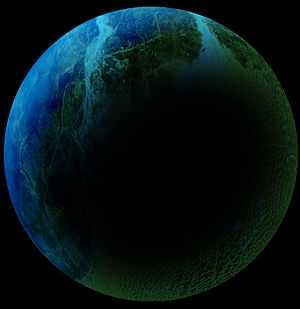HD 156668 b
| Extrasolar planet | List of extrasolar planets | |
|---|---|---|
 | ||
| Parent star | ||
| Star | HD 156668 | |
| Constellation | Hercules | |
| Right ascension | (α) | 17h 17m 40s |
| Declination | (δ) | +29° 13′ 38″ |
| Apparent magnitude | (mV) | 8.42 |
| Distance | 78.5 ± 2.0 ly (24.1 ± 0.6 pc) | |
| Spectral type | K2V | |
| Physical characteristics | ||
| Minimum mass | (m sin i) | 3.1 ± 0.4[1] M⊕ |
| Orbital elements | ||
| Semimajor axis | (a) | 0.04998 ± 0.00083[2] AU |
| Eccentricity | (e) | 0.000[1] |
| Orbital period | (P) | 4.6455 ± 0.0011[2] d |
| Argument of periastron |
(ω) | 0[1]° |
| Time of conjunction | (Tc) | 2454718.57 ± 0.11[2] JD |
| Semi-amplitude | (K) | 1.89 ± 0.26 [2] m/s |
| Discovery information | ||
| Discovery date | 2010-01-06 | |
| Discoverer(s) | Howard et al. | |
| Discovery method | Doppler Spectroscopy | |
| Discovery site | Keck Observatory | |
| Discovery status | Submitted | |
| Database references | ||
| Extrasolar Planets Encyclopaedia | data | |
| SIMBAD | data | |
| Exoplanet Archive | data | |
| Open Exoplanet Catalogue | data | |
HD 156668 b is an extrasolar planet orbiting the star HD 156668 78.5 light-years away in the constellation Hercules. It has a minimum mass of 3.1 Earth masses. At the time of discovery it was the second least massive planet discovered by the radial velocity method, subject to the mass/inclination degeneracy that affects radial velocity measurements.[3] The only radial velocity planet less massive than this planet is Gliese 581 e, which was discovered on April 21, 2009, and has a minimum mass of 1.94 Earth masses. In addition to this, it has the lowest semi-amplitude, or the speed of the stellar wobble caused by planet's gravity tugging on the star determined by radial velocity, at 2.2 m/s.[3] This planet was discovered on January 6, 2010; it is the 8th planet discovered in 2010 after the first five planets detected by Kepler on January 4 and two planets around HD 9446 on January 5.
References
- ↑ 1.0 1.1 1.2 Rebekah et al. (2010-05-21). "Radial velocity planets de-aliased. A new, short period for Super-Earth 55 Cnc e". arXiv:1005.4050. Unsupported parameter(s) in cite arXiv (help)
- ↑ 2.0 2.1 2.2 2.3 Andrew W. Howard, John Asher Johnson, Geoffrey W. Marcy, Debra A. Fischer, Jason T. Wright, Gregory W. Henry, Howard Isaacson, Jeff A. Valenti, Jay Anderson, Nikolai E. Piskunov (2010). "The NASA-UC Eta-Earth Program: II. A Planet Orbiting HD 156668 with a Minimum Mass of Four Earth Masses". v1. arXiv:1003.3444 [astro-ph.EP]. Unsupported parameter(s) in cite arXiv (help)
- ↑ 3.0 3.1 "Second Smallest Exoplanet Found To Date At Keck". W.M. Keck Observatory. 2010-01-07. Retrieved 2010-01-07.